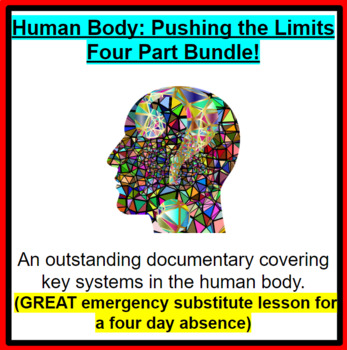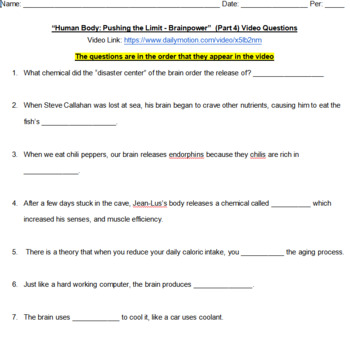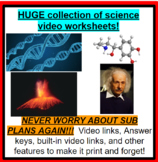Human Body: Pushing the Limits Bundle (4 Parts) - GREAT SUB PLANS!
Huge House of Science
255 Followers
Resource Type
Standards
NGSSMS-LS1-5
NGSSMS-LS1-7
NGSSHS-LS1-5
NGSSMS-LS1-2
NGSSHS-LS1-7
Formats Included
- Zip
Pages
4 pages
Huge House of Science
255 Followers
What educators are saying
These videos worksheets were perfect for a sub. The movie had them engaged and the questions were easily filled in by students.
Products in this Bundle (4)
Also included in
- This massive collection of video worksheets covers a number of NGSS standards. Each worksheet has a direct link to the video file built in to the worksheet, each worksheet has either fill in the blank or multiple choice question and EVERY worksheet has an answer key to go with it. Fool proof sub pPrice $37.10Original Price $53.00Save $15.90
- This is a collection of video worksheets revolving around life science topics. Each worksheet is either a multiple choice or fill in the blank worksheet with an answer key and each worksheet has a built in link to the video to minimize confusion. Never worry about sub plans for your life science cuPrice $5.25Original Price $7.50Save $2.25
Description
This collection includes questions for all four parts of "Human Body: Pushing the limits"; Strength, Brainpower, Sensation and sight. This is an outstanding series covering critical elements of human biology and just how amazing the human body is. This includes four worksheets with at least 10 fill in the blank questions each, answer keys and each individual worksheet has a direct link to each episode to eliminate confusion. This makes as WONDERFUL sub plan for a four day absence.
Total Pages
4 pages
Answer Key
Included
Teaching Duration
4 days
Report this resource to TPT
Reported resources will be reviewed by our team. Report this resource to let us know if this resource violates TPT’s content guidelines.
Standards
to see state-specific standards (only available in the US).
NGSSMS-LS1-5
Construct a scientific explanation based on evidence for how environmental and genetic factors influence the growth of organisms. Examples of local environmental conditions could include availability of food, light, space, and water. Examples of genetic factors could include large breed cattle and species of grass affecting growth of organisms. Examples of evidence could include drought decreasing plant growth, fertilizer increasing plant growth, different varieties of plant seeds growing at different rates in different conditions, and fish growing larger in large ponds than they do in small ponds. Assessment does not include genetic mechanisms, gene regulation, or biochemical processes.
NGSSMS-LS1-7
Develop a model to describe how food is rearranged through chemical reactions forming new molecules that support growth and/or release energy as this matter moves through an organism. Emphasis is on describing that molecules are broken apart and put back together and that in this process, energy is released. Assessment does not include details of the chemical reactions for photosynthesis or respiration.
NGSSHS-LS1-5
Use a model to illustrate how photosynthesis transforms light energy into stored chemical energy. Emphasis is on illustrating inputs and outputs of matter and the transfer and transformation of energy in photosynthesis by plants and other photosynthesizing organisms. Examples of models could include diagrams, chemical equations, and conceptual models. Assessment does not include specific biochemical steps.
NGSSMS-LS1-2
Develop and use a model to describe the function of a cell as a whole and ways the parts of cells contribute to the function. Emphasis is on the cell functioning as a whole system and the primary role of identified parts of the cell, specifically the nucleus, chloroplasts, mitochondria, cell membrane, and cell wall. Assessment of organelle structure/function relationships is limited to the cell wall and cell membrane. Assessment of the function of the other organelles is limited to their relationship to the whole cell. Assessment does not include the biochemical function of cells or cell parts.
NGSSHS-LS1-7
Use a model to illustrate that cellular respiration is a chemical process whereby the bonds of food molecules and oxygen molecules are broken and the bonds in new compounds are formed, resulting in a net transfer of energy. Emphasis is on the conceptual understanding of the inputs and outputs of the process of cellular respiration. Assessment should not include identification of the steps or specific processes involved in cellular respiration.






